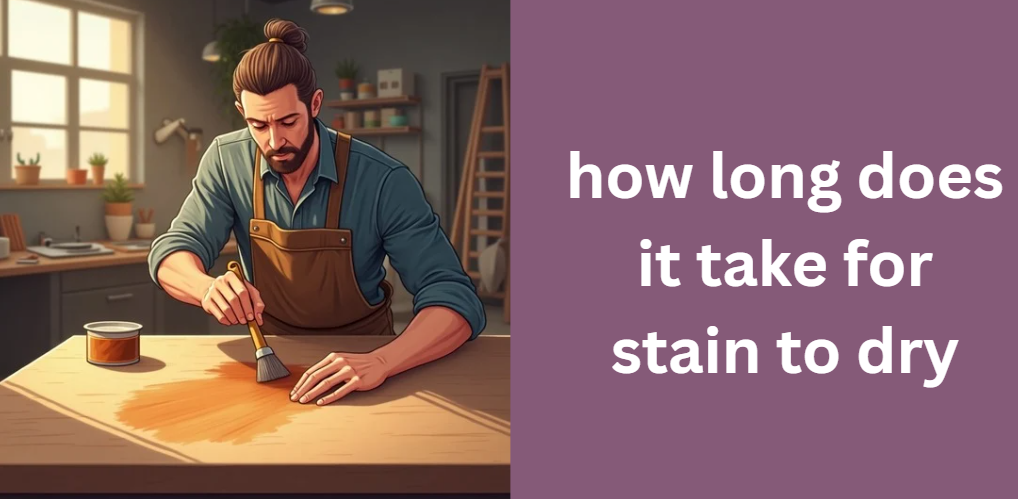Ultimate Guide to how long does it take for stain to dry
When it comes to achieving a flawless finish on your wood projects, knowing how long does it take for stain to dry is essential. Whether you are a seasoned woodworker or a DIY enthusiast, understanding the drying process will help you plan your work, avoid mistakes, and ultimately create beautiful, long-lasting results.
This guide covers everything you need to know—from the basics of stain drying to expert tips for speeding up the process, ensuring that your projects come out perfect every time.
Understanding the Basics of Stain Drying
Stain drying is the process by which the liquid components of a stain evaporate, leaving behind the pigments that penetrate the wood fibers. In simple terms, how long does it take for stain to dry refers to the time required for the stain to become touch-dry or fully cured.
Touch-dry means that the stain is no longer tacky to the touch, whereas full curing indicates that the stain has completely set and is ready for the application of a protective topcoat.
When you apply a stain to wood, solvents such as oils or water begin to evaporate. As these solvents leave the wood, the color pigments remain and bond with the wood fibers. The duration of this process depends on the stain’s chemical composition and several external factors. A clear understanding of these fundamentals is crucial for achieving the desired look and durability in your projects.
Factors Influencing Drying Time
There are several variables that determine how long does it take for stain to dry. These factors work together to affect both the touch-dry time and the full curing time of the stain.
Stain Type and Chemistry
Different stains, such as oil-based, water-based, and gel stains, have unique drying times. Oil-based stains often take longer to dry because they contain more solvent that needs to evaporate, whereas water-based stains typically dry faster. Gel stains, due to their thicker consistency, may require special attention to achieve an even finish.
Environmental Conditions
Temperature, humidity, and airflow are critical in determining drying times. Warmer temperatures and good air circulation speed up the drying process, while cooler temperatures and high humidity slow it down. For example, in a warm, dry workshop, you might find that a stain dries much quicker compared to a cold, damp day.
Wood Type and Preparation
The kind of wood you are working with also affects drying time. Softwoods, like pine or cedar, tend to absorb stain quickly but may need multiple coats, whereas hardwoods like oak or maple absorb stain more slowly, resulting in longer drying times. Additionally, proper wood preparation—such as cleaning, sanding, and ensuring the wood is completely dry before staining—plays a vital role in how evenly and quickly the stain dries.
Application Techniques
The method of application, including the tool used (brush, cloth, or sprayer) and the thickness of the coat, significantly impacts drying times. A thin, even coat allows solvents to evaporate rapidly, whereas a heavy application can lead to prolonged drying and even tackiness on the surface.
Below is a summary table that encapsulates these factors:
| Factor | Effect on Drying Time |
|---|---|
| Stain Type | Oil-based: Longer drying; Water-based: Faster drying |
| Environmental Conditions | Warm, low humidity speeds up drying; cold, high humidity slows it down |
| Wood Type | Softwoods: Quick absorption; Hardwoods: Slower absorption |
| Application Technique | Thin, even coats dry faster than thick, uneven applications |
Drying Time Guidelines for Different Stain Types
Knowing typical drying times for various stain types is key to planning your project schedule effectively.
Oil-Based Stains
Oil-based stains are favored for their rich color and durability but are known for longer drying times. In many cases, these stains may be touch-dry in about 8 to 10 hours. However, full curing may take anywhere from 24 hours to over a day, depending on environmental conditions.
Water-Based Stains
Water-based stains usually dry much faster than oil-based products. In optimal conditions, these can be touch-dry in as little as 1 to 6 hours. Despite the quick drying time, it is important to allow a full curing period—typically 24 hours—to ensure the stain has set properly.
Gel Stains
Gel stains, with their thicker consistency, often require a balanced approach to application. Their drying times can vary, but they generally fall somewhere between oil-based and water-based stains. Achieving an even coat is essential, and full curing might also take up to 24 hours.
Tips for Speeding Up the Drying Process
For those times when you need to know how long does it take for stain to dry more quickly, there are a few expert tips you can follow. One effective strategy is to improve ventilation in your workspace. Using fans or heaters can help maintain a warm, dry environment that promotes faster evaporation of solvents.
It is also important to apply stain in thin, even layers. A heavy coat not only takes longer to dry but can also result in a blotchy finish. In addition, working during the warmer parts of the day and avoiding high humidity conditions will naturally accelerate drying.
Here is a brief list of strategies to consider:
- Ensure proper airflow by using fans.
- Apply a thin, uniform coat.
- Work in a warm, dry environment.
- Avoid over-saturating the wood surface.
Common Problems and Troubleshooting
Despite careful planning, issues with drying may still occur. If you find that your stain remains tacky or appears blotchy, the problem may lie in environmental conditions or application technique. For example, if the stain does not dry as expected, it may be due to high humidity or insufficient ventilation. In such cases, consider moving your project to a more controlled environment or using a fan to help circulate air.
Other common issues include dust settling on the stain before it fully dries, which can affect the finish. Always ensure that the area is clean and free from airborne particles during the drying process.
Practical Applications and User Experiences
Real-world applications of stain drying vary by project. For outdoor decks, for instance, many woodworkers report that an oil-based stain takes about 8 to 10 hours to become touch-dry, but they wait at least 24 hours before applying a protective sealant. In contrast, water-based stains on furniture may only require a few hours before handling, yet still need a full day to cure.
These experiences highlight the importance of testing on a small, inconspicuous area before committing to a full project. Adjust your expectations based on your specific environment and the type of wood you are working with.
Expert Opinions and Interviews
Industry experts often stress that manufacturer guidelines are a helpful starting point, but real-life conditions can alter drying times significantly. Many professionals recommend always doing a test patch to see exactly how long does it take for stain to dry in your particular setting. Their advice emphasizes the importance of adapting to variables such as weather and wood type for optimal results.
One seasoned woodworker explained, “I always give my projects extra time to cure. Even if a stain seems dry to the touch, I wait a full day before adding any topcoat to ensure a perfect finish.” Such insights reinforce the necessity of patience and precision in wood finishing.
Frequently Asked Questions
How can I accurately determine if my stain is fully cured without risking damage to the finish?
You can use non-invasive tools like a moisture meter or a durometer to measure the hardness of the stain once applied. Testing on a discreet area also allows you to gauge whether the finish has reached full durability without interfering with the overall look.
What are the potential risks of using artificial heat sources like hair dryers or heat guns to speed up drying?
While these methods can accelerate drying, they might cause uneven drying or even damage the finish if used too aggressively. Overheating may lead to blistering or altered color consistency, so it is important to use these tools cautiously and follow manufacturer recommendations.
Does the color or pigment concentration of a stain affect its drying time?
Yes, darker or more heavily pigmented stains may take slightly longer to dry because of the additional solids and thicker application needed. This can affect both the drying time and the final appearance of the wood, requiring careful testing and application.
How does surface contamination, such as dust or grease, impact the drying process of a stain?
Any contaminants on the wood surface can interfere with stain absorption and evaporation. Dust and grease can create a barrier, causing the stain to dry unevenly or extend drying time, and may also result in blotchiness or adhesion problems later on.
Are there any specialized environmental monitoring tools that can help optimize conditions for drying stain?
Yes, tools like hygrometers and digital thermometers can help you track ambient humidity and temperature. By monitoring these conditions, you can adjust your workspace—such as by increasing ventilation or using a dehumidifier—to create the ideal environment for the stain to dry uniformly and efficiently.
Conclusion
In conclusion, how long does it take for stain to dry depends on multiple factors including the type of stain, environmental conditions, wood type, and application techniques. This comprehensive guide has explored these elements in detail, providing practical tips and expert advice to help you achieve a flawless finish.
By understanding and controlling these variables, you can ensure that your wood projects not only look beautiful but also stand the test of time. Whether you choose oil-based, water-based, or gel stains, applying them correctly and allowing sufficient drying time is the key to success.
Embrace these insights and let your woodworking projects shine with a finish that is both durable and visually stunning.
Read more
Comprehensive Guide to fix on six mini implants erie pa
techoelite preferred on gaming: The Ultimate Comprehensive Guide
Deforest Kelley on QVC 1986: A Comprehensive Guide
The Ultimate Guide to achilies heel swade spc
The Ultimate Guide to florsheim men’s annuity chukka boot burgundy






